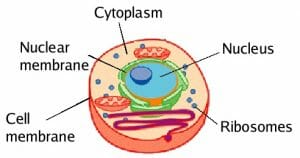Protoplasm Definition
The word protoplasm is generally used to refer to the living parts of a cell, but can have slightly different meanings in different circles. The term protoplasm is not often used these days, however, due to the fact that it was initially used to imply that a cell only contains two components, a nucleus and a simple, homogenous cytoplasm. Nowadays, we know that the cytoplasm is very complex and that it contains intricate organelles. Nevertheless, in eukaryotes, such as plants and animals, we now refer to the protoplasm outside of the nucleus as the cytoplasm, and the protoplasm inside the nucleus as the nucleoplasm. In prokaryotes, the contents of a cell are collectively called the cytoplasm.
Components and Functions of a Protoplasm
The first component of the protoplasm is the cytoplasm, which exists between the cell membrane and the nucleus in eukaryotes, as we can see below. It is where the organelles with various essential functions are found. The cytoplasm is responsible for maintaining an environment that can allow the different organelles within it to carry out their functions. For example, in plants, the cytoplasm is the site of some very important reactions of photosynthesis. The cytoplasm also plays a role in keeping the cell’s shape and in storing the chemicals and substances that the organelles need. The fact that it’s liquid also means that substances can travel within a cell and be transported to other cells easily.
The second element in the makeup of protoplasm is the nucleus. It contains the genetic material of a cell or organism. It also plays a role in controlling the activity of the cell. Additionally, the nucleus is the place where ribosomes, which are essential in creating proteins in the cell, are made. Prokaryotes do not contain a nucleus, but rather have a region called the nucleoid where their genetic information is found.
Molecules including proteins, fats, enzymes, hormones, and other substances are of course all a part of the makeup of the protoplasm. We can find these substances either dissolved in the water component of the protoplasm or suspended within it. The protoplasm, then, is pretty fascinating and complex, and not at all plain or simple.
Related Biology Terms
- Cell wall – A firm outer layer found in some cells, such as plant and bacterial cells, providing protection and shape.
- Cytoskeleton – A system of fibers made of proteins found in the cytoplasm of cells.
- Nucleolus – A small structure within a nucleus where ribosome assembly occurs.
Quiz
1. The two components that make up the protoplasm are:
A. The cell membrane and cytoplasm
B. The nucleolus and cytoplasm
C. The nucleus and cytoplasm
D. The cytoskeleton and cell membrane
2. Which of the following is true of the cytoplasm?
A. It’s a rigid outer layer that protects the inside of the cell.
B. It maintains a suitable environment for the organelles within it to function properly.
C. It is the organelle responsible for making ribosomes.
D. It is the photosynthesizing organelle in plant cells.

